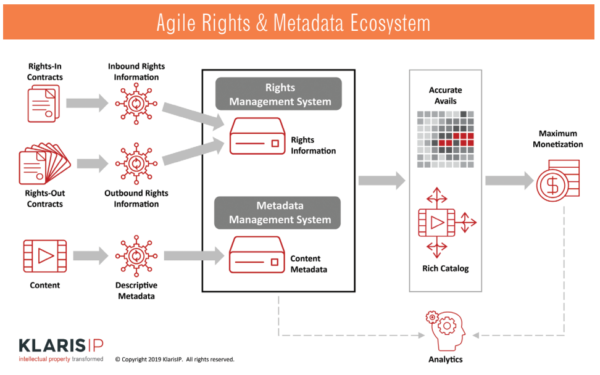HITS

M&E Journal: The Rights and Metadata Agility Imperative
Story Highlights
By Ross French, Senior Director, and Alex Akers, Manager, Consulting, KlarisIP –
Sam leads the sales team for a media content company — a well-oiled machine that has been making conventional content deals for years. One day her chief strategy officer calls and says “We’re going to launch an entirely new streaming service of our own. I need to know what content we own the rights to stream in each of our top 25 global territories and the expiration dates for all existing licensing deals that would prevent us from including a particular title in the launch. And, I need this information in 48 hours.”
This is the kind of life-changing scenario our clients are either experiencing today or fearing that they will experience soon.
Conventional content sales processes have depended on metadata and IP/rights data retrieval within a reasonable turnaround. However, in this new era where distribution channels and subchannels have proliferated, we’ve found that these legacy processes and systems are simply unable to keep up with the velocity of demand. The days of trading emails back and forth with the legal or clearance teams are nearly over, and the modern media company must be both agile and organized, not just to support, but to drive, new business.
In reality, Sam will never be the only employee who needs access to key media rights information. What if her counterparts in brand marketing are planning a series of social media posts using IP that was acquired well before Instagram? What if there are ad/promo restrictions for a title that must be considered before it goes up on the streaming service? To succeed in this new media landscape, sales decisions must occur in a matter of minutes, not weeks or months. Information needs to be readily available, and comprehensible, to serve these growing demands effectively.
Unfortunately, in many organizations the descriptive and rights information is owned by separate teams, which makes it difficult to have a holistic, 360-degree content view. This issue becomes especially compounded by inconsistent, duplicate and delayed data entry.
To counteract this, we must adjust by redefining processes and implementing systems that not only service existing demand but establish agility to tackle the next waves head-on.
So how do we get started? In our experience, it requires organizational evolution in three key areas.
People: Fostering a culture of data- sharing
Legacy data sharing mechanisms typically required a high level of manual interaction using primitive tools and information silos: an analyst would own the title master, lawyers would file the deals as they were drafted, and another analyst would painstakingly maintain spreadsheets, or maybe a standalone sales/avails tool, to determine availabilities.
In short, little was integrated, and while avails data could be used to identify potential sales, inevitably the sales team would contact the legal team to validate along the way. While technology has improved the ability to organize this information, key rights data is still often siloed and not readily available for self- service. As a starting point in the shift towards a modern rights organization, companies should nurture a culture in which rights information and product metadata are enterprise-level “assets” with enterprise accessibility.
The business must drive
Technology teams can deliver highly effective platforms to manage processes and data, but this is not solely a technology challenge. To achieve a new atmosphere where data sharing is ingrained within the culture, business, legal and IT must lead together, in close partnership.
 Organizational change
Organizational change
Change management — we’ve heard it all before, but it can make a real difference in overcoming the legacy silos, boundaries and “territoriality” among information stewards. Companies must identify how each role and actor will benefit from the new information order and find the executive champions to support that.
A legal analyst who has defined their existence in terms of reactive clearances, for example, may find a more fulfilling (and visible) personal platform in the proactive analysis of monetizable rights buried within the existing library.
Process: Efficiently capturing and sharing data
Capturing information as close as possible to its “birth,” and propagating it to all who rely on it, is paramount to building a nimble and responsive content organization.
Capture data throughout the content supply chain
Take an inventory of all the points in the current content supply chain where information is added, then evolve the surrounding processes to automate as much as possible. Advances in AI and machine learning open up interesting new opportunities to harvest data from previously manual sources, like contracts. Ideally, if the legal team is authoring contracts directly into a contract management system, it may be possible to capture some key information as it is entered.
Establish data quality standards and govern accordingly
With data harvesting optimized, establish processes to assess and validate the quality of the data. This challenge becomes particularly daunting if the information exists in a number of systems. Think of data quality standards that eliminate the potential for misinterpretation. Establish data governance processes to review and evaluate the quality of the information periodically.
Technology: Implementing systems
While data and processes are closely related, day-to-day business needs vary such that organizations generally require multiple integrated systems across the content supply chain. These tools should be optimized for self-service — for example, to inform business users so they can make some decisions without requiring a lawyer (maybe not for all decisions, but enough to make a material improvement in the organization’s agility).
Establish an information model
Define an information model that provides a holistic view of the data across systems and supports each user role in the supply chain. While users may not all use the same tools, much of the underlying data will be the same. Understand which sources are authoritative and which are copies, and build data flows/ integrations accordingly. Design the technology environment to provide a seamless, central view of the information on which your users depend.
Have a roadmap
The change required to elevate an organization extends into many areas, so start by building a roadmap that lays out all these evolutions smartly. This plan should identify quick-win phases, allowing for incremental milestones and benefits so that stakeholders are encouraged to continue and complete the journey.
Conclusion
Legacy media and rights information processes used to rely on human communication across business and legal teams, consuming that most precious of resources — time — especially if a request required unearthing and reading actual contracts.
Now, thoughtfully designed and well implemented technology platforms have the potential to deliver key answers in minutes. Sam’s traditional sales processes can be streamlined, automated, and in helpful ways pushed down, self-service style, to her agents out on the festival circuit. Additionally, her new world order driving major content strategies, like laying out a release plan for direct to consumer streaming platform, can be delivered within hours.
The new media landscape requires a new information agility. Enable rights and descriptive data to flow automatically to all points of the content ecosystem quickly, accurately, and in a form in which it can maximize monetization when the opportunity arises.
This is the future reality — or maybe the present imperative — for content owners today.
———–
Click here to translate this article
Click here to download the complete .PDF version of this article
Click here to download the entire Spring/Summer 2018 M&E Journal









